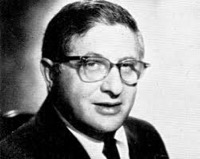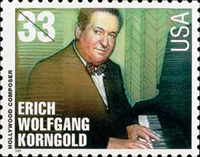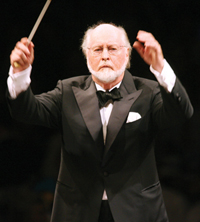| Cinematic Classics | ||||||||||
Overture to North by Northwest The film music scene in Hollywood of the 1930s and early 40s was dominated by German and Austrian émigrés who had escaped Nazism. But by the late 1940s, American-born composers began taking over. Born in New York to Russian émigré parents, Bernard Herrmann graduated from Juilliard and became by mid-century one of the most sought-after composers of movie and TV music. He is best known for his collaboration with Alfred Hitchcock, Orson Welles and Rod Serling. His last score was for Martin Scorsese’s The Taxi Driver. Hitchcock’s 1959 movie North by Northwest is a complicated story of a hapless advertising agent mistakenly identified as a foreign agent involved in the theft of government secrets. In the overture – or title sequence – Herrmann created music of an eerie and relentless quality.  | ||||||||||
Violin Concerto in D major, Op. 35 Erich Wolfgang Korngold is a representative of the last gasp of the spirit of late romanticism in Vienna. He never veered from this established idiom and never ventured into modernistic experiments. He was a true child prodigy whose works were performed in public in Vienna by the time he was 11 (the fact that his father was the music critic of Vienna's most prestigious newspaper, Neue Freie Presse, may have helped). In the early part of the century Korngold was known mainly through his operas (Violanta, Die tote Stadt, Das Wunder der Heliane) but today he is primarily remembered by his pioneering film music. At the urging of the director Max Reinhardt, with whom he had staged Die Fledermaus in Berlin in the 1920s, he came to Hollywood in 1934 where he wholeheartedly embraced the new medium and, incidentally, saved his life. By the time Korngold came to Hollywood, his “classical” compositions were regarded as superficial and irrelevant to the proponents of mainstream twentieth-century modernism. But Hollywood adored him. Korngold saw film as the true successor to the operatic stage. His success as film music composer was phenomenal, two of them, Anthony Adverse (1936) and Robin Hood (1938), won Oscars. The film music scene in Hollywood of the 1930s and 40s was dominated by German and Austrian émigrés who had escaped Nazism. It is not surprising, therefore, that when Korngold once again took up his classical pen in 1945 to write his Violin Concerto he dedicated it to an old family friend, the doyenne of the émigrés, Franz Werfel's wife and Gustav Mahler's widow, the legendary Alma Mahler. No less a master than Jascha Heifetz premiered the concerto in St. Louis. It is an amusing exercise, when listening to the Concerto, to note how many themes and passages immediately call to mind the musical conventions we have come to associate with certain kinds of film action. We make these associations on the basis of countless hours of movie going, during which the musical “language” has implanted itself in the subconscious – perhaps even into the collective unconscious – and controlled our emotional response. In the Concerto Korngold reworked music from his successful film scores, including Juarez (1939), Anthony Adverse (1936), Another Dawn (1937) and The Prince and the Pauper (1937). But the Concerto is not all “movie music.” Korngold transforms the themes to conform to the concert conventions of the concertos of composers from Mendelssohn to Max Bruch. The technical and expressive demands, as well as the harmonies, surpass melodic clichés. Although it reflects the composer’s nostalgic attachment to fin-de-siécle Viennese romanticism, even the most discerning twenty-first-century ears are eclectic and accepting, no longer trapped in the clutches of atonal dogma. Most important of all, Korngold’s writing for the violin is everything a soloist could dream of. The first movement main theme, from Another Dawn, is a multifaceted melody and an ancestor of the Star Trek theme.  The more sentimental, second theme is from Juaréz. The more sentimental, second theme is from Juaréz.  The development inhabits the violin’s stratosphere. The development inhabits the violin’s stratosphere.  The second movement is a rhapsodic romantic fantasy on a theme from Anthony Adverse.  As opposed to the sprawling melodies from the first movement, this one is surprisingly simple. Heating up the passion, Korngold uses a more expansive melody for the middle section. As opposed to the sprawling melodies from the first movement, this one is surprisingly simple. Heating up the passion, Korngold uses a more expansive melody for the middle section.  In the energetic, humorous finale, Korngold teases the listener by delaying an outright statement of the movement’s single theme, from The Prince and the Pauper. Instead, the soloist starts with a fanciful melody containing hints of the theme;  for a couple of minutes, both violin and orchestra pursue the elusive melody until the soloist finally “pins it down.” for a couple of minutes, both violin and orchestra pursue the elusive melody until the soloist finally “pins it down.”  The whimsical fantasy puts the little melody and the soloist through their paces. The whimsical fantasy puts the little melody and the soloist through their paces. | ||||||||||
The Film Scores In the 1930s and 40s the major Hollywood studios hired established classical composers – many of them refugees from Nazi Germany – who went on to develop a language of cinematic music that was as important a factor in controlling viewers’ emotional responses as the acting and cinematography itself. Some of the best-known names are Erich Wolfgang Korngold, Kurt Weill, Miklós Rózsa and Marvin Hamlisch. John Williams was heir to this tradition; since the 1960s he has expanded and deepened that language to become the most important film composer of all time. The industry’s premier directors, especially George Lucas and Stephen Spielberg, have sought him as a partner, and their combined efforts have garnered armloads of awards, with Williams himself receiving as of this date five Academy Awards, four Golden Globe Awards and 21 Grammys. He holds the record for the Oscar nominations. In addition to his film scores, Williams has also composed extensively for the concert hall. His symphonies, the Violin Concerto, Flute Concerto, Bassoon Concerto and numerous chamber works, have been performed around the world, especially by the Boston Pops, which he conducted between 1980 and 1993. Williams’s greatest gift is his ability to create music that captures precisely the theme of a film as a whole as well as the mood of the moment. When George Lucas needed a composer to match his grand space epic, Star Wars, Williams produced a grand Wagnerian score with Leitmotifs and all. For Jaws (1975), Williams said it all in two – now iconic – notes. Steven Spielberg’s Schindler’s List, (1993) required the sensitivity and delicacy to enable audiences to focus on the individual tragedies on the one hand and the “banality of evil” on the other. Williams had been reluctant to take on the job, telling Spielberg: “You need a better composer than I am,” “I know,” Spielberg countered, “but they are all dead.” When Williams composed the music for Harry Potter and the Sorcerer's Stone in 2001, he initially wrote “Hedwig’s Theme” – who, just in case anyone out there doesn’t know, is Harry’s owl – as a “darkly alluring orchestral waltz” for the first movie trailer. At the time Williams commented, ''everyone seemed to like it, so I will probably use that music as one thread in the tapestry.'' In fact, “Hedwig’s Theme” has become the most recognized theme in the entire series, acquiring a life of its own, in association with other magical characters and spells. Williams featured the bell-like celesta over a swirling string accompaniment. Williams worked other magical melodies into a suite of themes from the film that he called “Harry’s Wonderous World.” Major instrumental numbers accompany specific scenes in the film. For Fluffy, the three-headed dog guarding the chamber where the Sorcerer’s Stone is located who can be soothed only by a magic harp, Williams created a duet for harp and contrabassoon. The creator of the Olympic fanfare provided a signature brass showcase for “Quidich.” A “Wizard’s” chamber ensemble, including recorder, upper winds, finger cymbals, strings and a pair of xylophones portrays the shopping emporium Diagon Alley, the hidden magical shopping center in London. E.T.: The Extraterrestrial (1982) is considered by many as Spielberg’s best movie. It has been described as: “Both a classic movie for kids and a remarkable portrait of childhood, [it] is a sci-fi adventure that captures that strange moment in youth when the world is a place of mysterious possibilities (some wonderful, some awful), and the universe seems somehow separate from the one inhabited by grown-ups.” Once again, Williams was able to balance the film’s child-like innocence with the musical vocabulary of Science fiction. The film's final chase and farewell sequence is one of the few instances in film history in which the on-screen action was re-edited to conform to the composer's musical interpretation (Sergey Prokofiev’s score to Alexander Nevsky is another one). The score garnered Williams his fourth Academy Award. Williams’s ability to garner a universal response cuts across genres, media and occasions: From Monday Night Football and the Olympics to President Obama’s inauguration. | ||||||||||
| Copyright © Elizabeth and Joseph Kahn 2017 | ||||||||||


